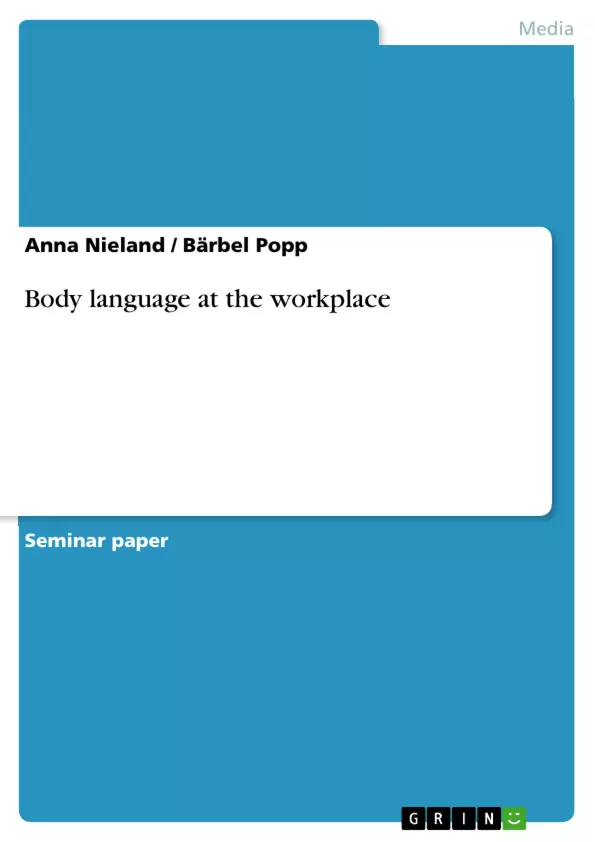In the following written assignment we are going to discuss the topic “Body language at the workplace”. To be able to understand what body language is about, there will be a definition which will afterwards lead to a description of the criteria of selective notice.
Body language is also known as nonverbal communication and that is why the importance of nonverbal communication plays a crucial role in our everyday life we cannot control. At this point of the written assignment there should be a better knowledge of body language and therefore the relationship between the spoken and the unspoken words are analysed. This is very important because nonverbal and verbal communication always go hand in hand.
As we already experienced and will experience in our career there are many different cultures and with that many different cultural meanings of body language, especially in mimic and gesture. Because of the internationality in the world and the everyday contact to other cultural groups we have to understand the meaning of their body language. We will underscore this with some examples chosen.
Our actual topic “Body language at the workplace” is divided into four chapters beginning with the career interview in which the most important behaviours – we have to pay attention to - are explained. The occupational body language deals with the kind of body language you automatically use according to your job and workplace. Because of our field of studies we will go into the effective use of meetings which might be seen as a little guide to the future. To ensure a good work climate, attitudes to workmates play an important role because in regard to your behaviour you will be either respected or disrespected. And because it is important for business people to know if their opposite is lying we figured out the main aspects to expose the liar.
With our last point we are trying to show how easy it is to manipulate your own body language which makes it even harder for others to understand the meaning of it.
Table of Contents
- I. Introduction
- II. Definition of body language
- III. Criteria of selective notice
- Posture:
- Mimic:
- 1. Personal habits
- 2. Emotions
- 3. Interaction signs
- Gesture:
- Distance:
- Intimate zone (15 – 46 cm):
- Personal zone (46cm – 1,2m):
- Social zone (1,2 – 3,6m):
- Public zone (over 3,6m):
- Sound of voice:
- 1. Clothing
- 2. Emblems and jewellery
- 3. Hairstyle
- 4. Face and skin
- 5. Physique
- IV. Importance of nonverbal communication
- V. Relationship between nonverbal and verbal communication
- 1. Repeat what is said verbally
- 2. Substitute for portions of the verbal message
- 3. Complement or clarify the verbal message
- 4. Contradict the verbal statement
- 5. Emphasize the words
- VI. Cultural differences
- Facial expressions:
- Physical contact:
- Gaze:
- VII. Body language at the workplace
- 1. The career interview
- 1. First meeting
- 2. Tune your body posture
- 3. What to do with your hands/arms
- 4. Movements: A dynamic interview?
- 5. Furthermore
- 2. Occupational body language
- 3. The effective use of meetings
- 1. What to do with your eyes?
- 2. What do your facial expressions indicate?
- 3. Positioning and movement of your body and limbs
- 4. Hand gestures
- 4. Attitudes to workmates
- 5. Lying: Revealing and concealing information
- 1. Stress signals
- 2. Less conscious of feet and legs
- 3. Posture is more honestly
- 4. Expensive gestures decline
- 5. Shifty gazes
- 1. The career interview
- VIII. Manipulation of body language
- 1. Definition:
- 2. Politics
Objectives and Key Themes
This written assignment aims to provide an in-depth understanding of body language in the workplace. It begins with a definition of body language and explores the criteria of selective notice, examining various nonverbal communication components like posture, mimic, gestures, distance, and the sound of voice. The importance of nonverbal communication is then discussed, highlighting its omnipresence, potential for misunderstanding, interaction primacy, expressive capabilities, and trustworthiness. The relationship between verbal and nonverbal communication is analyzed, exploring how they can complement, substitute, clarify, contradict, or emphasize each other.
- The role of nonverbal communication in the workplace
- The impact of cultural differences on body language interpretation
- Effective communication strategies through body language
- The relationship between body language and professional success
- The potential for manipulation of body language
Chapter Summaries
The introduction sets the stage for the discussion of body language in the workplace, defining the concept and outlining the key topics to be covered. Chapter II delves into the definition of body language, emphasizing its ubiquitous nature in face-to-face interactions and its role in conveying unspoken messages. Chapter III elaborates on the criteria of selective notice, focusing on various nonverbal communication components like posture, mimic, gestures, distance, and the sound of voice. Chapter IV examines the importance of nonverbal communication, highlighting its omnipresence, potential for misunderstanding, interaction primacy, expressive capabilities, and trustworthiness. Chapter V delves into the relationship between verbal and nonverbal communication, exploring how they can complement, substitute, clarify, contradict, or emphasize each other. Chapter VI focuses on cultural differences in body language, particularly in terms of facial expressions, physical contact, and gaze.
Keywords
This work focuses on the importance of nonverbal communication, specifically body language, in the workplace. It explores various aspects of nonverbal communication including posture, mimic, gestures, distance, and the sound of voice. Cultural differences, manipulation of body language, and the impact of nonverbal communication on professional success are also key themes. The text utilizes examples and insights from different sources to provide a comprehensive understanding of body language in various workplace settings.
- Arbeit zitieren
- Anna Nieland (Autor:in), Bärbel Popp (Autor:in), 2006, Body language at the workplace, München, GRIN Verlag, https://www.grin.com/document/74383



